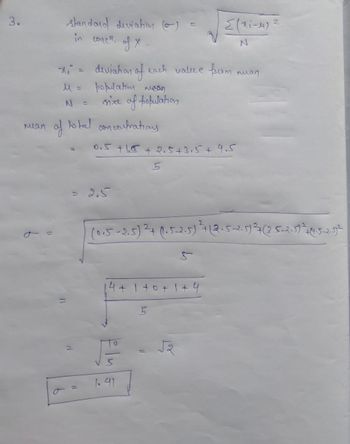A compound X is to be determined by UV/visible spectrophotometry. A calibration curve is constructed from standard solutions of X with the following results: - 0.50 ppm, A = 0.24; - 1.5 ppm, A = 0.36; - 2.5 ppm, A = 0.44; - 3.5 ppm, A = 0.59; and - 4.5 ppm, A = 0.70. Find the following: A. Slope and intercept of the calibration curve B. The mean concentration of the solution of unknown X concentration if the absorbance of 3 replicates are A = 0.29, A = 0.30 and A = 0.32. C. The standard deviation in the concentration of X
A compound X is to be determined by UV/visible spectrophotometry.
A calibration curve is constructed from standard solutions of X with the following results:
- 0.50 ppm, A = 0.24;
- 1.5 ppm, A = 0.36;
- 2.5 ppm, A = 0.44;
- 3.5 ppm, A = 0.59; and
- 4.5 ppm, A = 0.70.
Find the following:
A. Slope and intercept of the calibration curve
B. The mean concentration of the solution of unknown X concentration if the absorbance of 3 replicates are A = 0.29, A = 0.30 and A = 0.32.
C. The standard deviation in the concentration of X
Trending now
This is a popular solution!
Step by step
Solved in 4 steps with 1 images

For the calculation of sd, shouldn't it be (0.97-1.09) and so on... because 0.97 = x and 1.09 = mean?
and the formula for sd is squared of the summation of (x-mean)^2 divide by n?
For the standard equation, shouldn't it be (0.97-1.09) and so on... because (x-mean)
For C, shouldn't be like this?

How did you get y=0.115x+0.1785? And r^2= 0.9935








